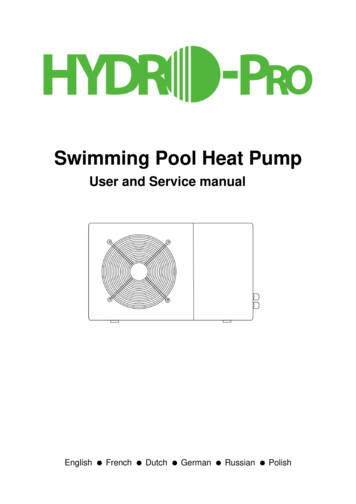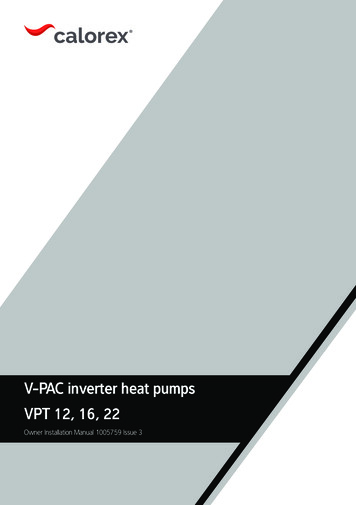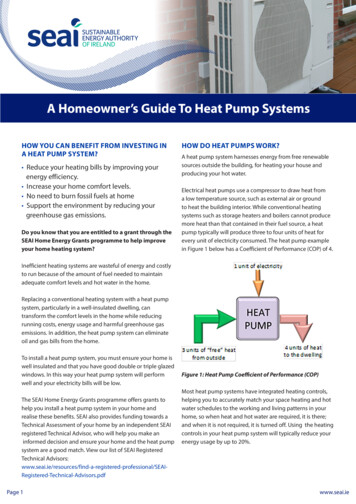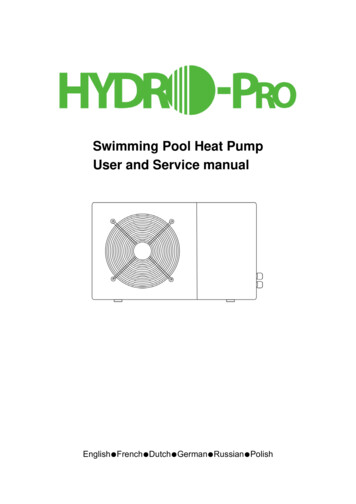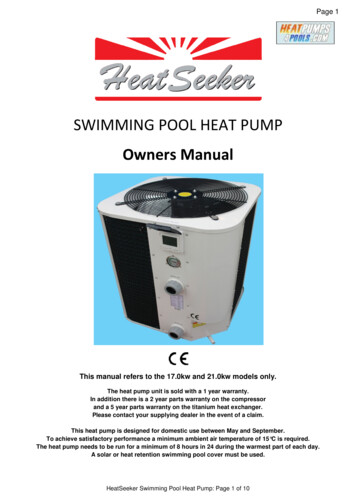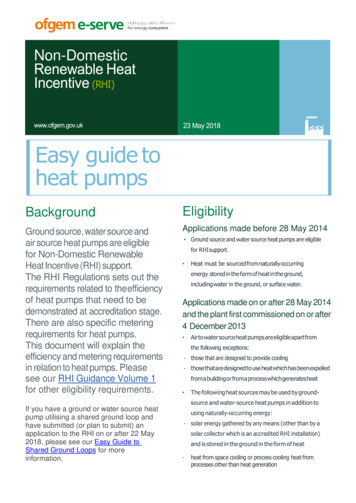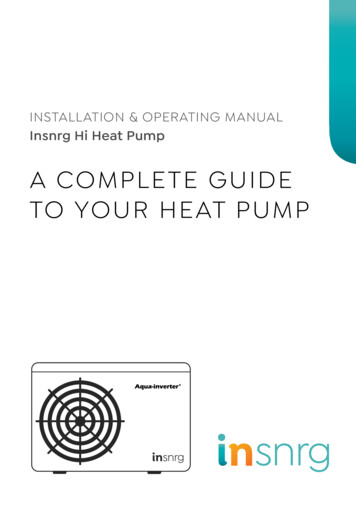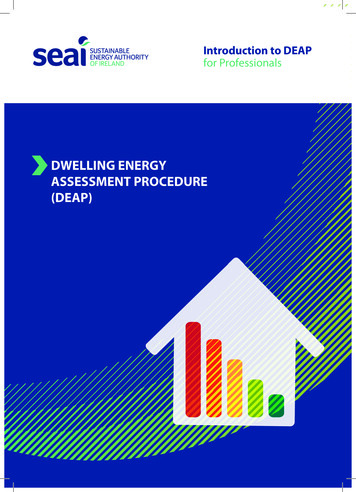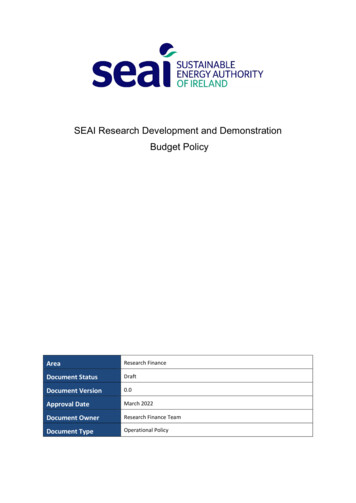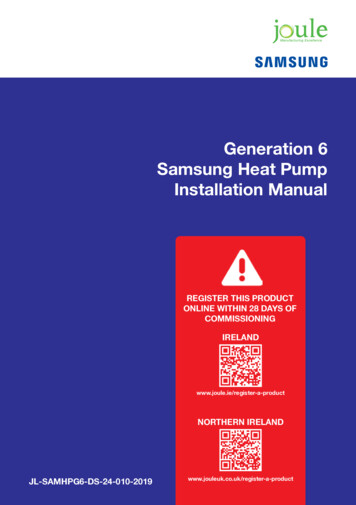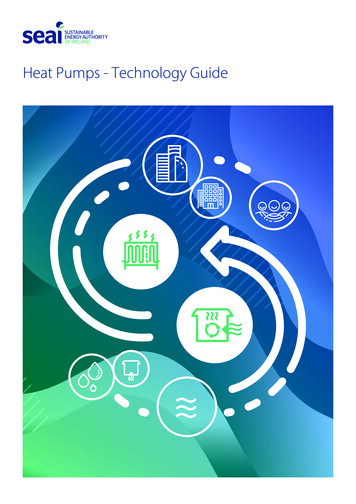
Transcription
Heat Pumps - Technology Guide
Heat Pumps Technology GuideSEAIHeat Pumps Technology GuideAugust 2020Report prepared for SEAI by:Ricardo Energy & EnvironmentDisclaimerWhile every effort has been made to ensure the accuracy of the contents of this report, SEAI accepts no liabilitywhatsoever to any third party for any loss or damage arising from any interpretation or use of the informationcontained in this report, or reliance on any views expressed therein. Public disclosure is authorised. This guide maybe reproduced in full or, if content is extracted, then it should be fully credited to SEAI.Sustainable Energy Authority of IrelandSEAI is Ireland’s national energy authority investing in, and delivering, appropriate, effective and sustainablesolutions to help Ireland’s transition to a clean energy future. We work with Government, homeowners, businessesand communities to achieve this, through expertise, funding, educational programmes, policy advice, research andthe development of new technologies.SEAI is funded by the Government of Ireland through the Department of Communications, Climate Action andEnvironment. Sustainable Energy Authority of IrelandReproduction of the contents is permissible provided the source is acknowledged.
Heat Pumps Technology GuideContents1. Introduction1.1.1.2.2.Purpose of this guideScopeOverview of heat pumps2.1.Concepts2.2.Heat pump cycle types2.2.1.Vapour compression cycle heat pumps2.2.2.Transcritical heat pumps2.2.3.Absorption heat pumps2.3.An efficient and reliable heat pump system2.3.1.Heat pump2.3.2.Other system components2.3.3.The building2.3.4.Thermal insulation of components2.4.Measures of efficiency2.4.1.Seasonal performance factor2.4.2.Coefficient of performance2.4.3.Seasonal coefficient of performance3.Heat sources3.1.Air-to-water3.2.Ground-to-water and water-to-water3.2.1.Types of system3.2.2.Heat r3.2.5.Shared ground- or water-source system3.2.6.Other considerations3.3.Air-to-air4.Heat distribution systems and factors influencing their design4.1.Accurate determination of heat load4.2.Radiators4.2.1.Oversizing standard steel radiators4.2.2.Low-temperature radiators4.3.Hydronic underfloor heating4.3.1.Suspended timber floors4.3.2.Floor coverings4.3.3.Retrofit4.4.Integrating heating, ventilation and air-conditioning4.5.Hot water provision4.6.Process and other heat use4.7.Pipework and n with other heat sourcesBivalent parallelBivalent 7181818181919202020212122222323262727
Heat Pumps Technology Guide6.6.1.6.2.7.7.1.7.2.8.ControlsWeather compensationSpeed controlBuffers tanks and thermal storesOperationSeasonal thermal storesMeteringSEAI282828293030318.1.Heat metering8.1.1.Principles and types of meter8.1.2.Flow sensors8.1.3.Temperature sensors8.1.4.Integrators8.2.Meter classifications8.3.Installation8.4.Maintenance and calibration8.5.Electricity metering8.6.Data logging313132323233333435359. Electricity supply issuesAppendix 1: Heat pump concepts3637A.1. ConceptsA.2. Heat pump cyclesA.2.1. Vapour compression cycleA.2.2. Transcritical heat pumpsA.3. Absorption heat pumps3737383939
Heat Pumps Technology Guide1.SEAIIntroductionIreland has a long-term vision for a low-carbon energy system. It aims at reducing greenhouse gas emissions fromthe energy sector by between 80% and 90% (compared with 1990 levels) before 2050. Achieving this target willrequire a radical transformation of Ireland’s energy system, a reduction in energy demand, and a move away fromfossil fuels to zero- or low-carbon fuels and energy sources.Air-, ground- and water-source heat pumps extract naturally occurring, renewable heat and upgrade it to atemperature at which it can be used for heating or cooling loads. Heat pumps use some electricity to operate,usually between 25% and 40% of the heat output, which means that efficiencies of 250% to 400% can be achieved.In other words, up to four units of heat are delivered for every unit of electricity used. Properly designed andinstalled heat pumps are cheaper, and have lower emissions, than fossil fuel or electric heating. Compared to otherrenewable heat solutions such as biomass, they also offer advantages such as significantly lower maintenancerequirements and freedom from delivery charges.Correct preparation at the design, installation and operational stages, helps to ensure that a heat pump system isefficient and reliable, with optimised value for cost, and low emissions. The heat pump, the system to extract therenewable heat produced, and the heat distribution system must be designed and installed correctly.This guide is provided as part of a suite of three heat pump guides: an Implementation Guide, a Technology Guide,and an Operation & Maintenance Guide, which collectively aim at providing an understanding of heat pumptechnology, its implementation and operational management.1.1.Purpose of this guideThis guide is principally intended for owners, engineers and consultants, particularly those with limited experienceof heat pump systems. It is also useful for facilities and engineering managers, environmental managers andtechnical maintenance staff, it: Sets out good practice for implementing heat pump systems; and Lists sources with more detailed information on aspects of the technology.This guide and its two companion guides do not replace existing publications; rather they are intended as acomprehensive starting point for those wishing to better understand the technology, its implementation andmanagement.1.2.ScopeThis is one of three guides: The Implementation Guide focuses on the decisions associated with each stage of a heat pump project; The Operation & Maintenance Guide gives information on operating a heat pump system; and This Technology Guide describes in more detail the different parts of a heat pump system.These guides focus on heat pump systems for non-domestic premises, using packaged heat pumps with aninstalled capacity of 45 kW to 1 MW of heat output. Much of the guidance will also apply to smaller scale systems.Large bespoke heat pump systems and direct air heating systems are not within the scope of this guide. This guidefocuses on heat pump systems that distribute heat through water-based systems for use in non-domestic space-,water- and process-heating.You should read the whole guide before implementing a heat pump system.1
Heat Pumps Technology Guide2.SEAIOverview of heat pumpsKey messages A heat pump system is a sealed loop that contains a gas. It uses an electrically driven compressor tocompress the gas, taking it from a low temperature and pressure to a higher temperature and pressure.One of the main factors that effects heat pump system efficiency is the difference between the meantemperature in the evaporator and the temperature in the condenser.Heat pump performance efficiency is measured by the coefficient of performance. This is the ratio ofheat output to electricity input at a specified set of operating temperatures for the flow and return in theheat source system, and the flow and return in the heating system.The seasonal performance factor is the ratio of the units of heat delivered in kWh over one full year tothe units of electricity consumed over that same period. It is a measure of the heat pump system’soperational performance.Heat pumps are similar to refrigerators and air-conditioning systems: they use a refrigerant cycle to extract very lowgrade heat (usually under 25 C) and upgrade it to a higher temperature.A heat pump consists of three linked systems: The source, from where heat is extracted, e.g. air or water; The refrigeration system, which upgrades/generates the heat; and The heat distribution system, which brings the heat to the points of use, e.g. radiators.Heat pumps can supply different types of heat distribution systems. Some heat air directly, whereas others provideheat through water. These ‘wet systems’ are normally used for space heating or hot water supply. This guide focuseson heat pumps that distribute heat through water.Figure 1: Basic diagram of a heat pump2
Heat Pumps Technology Guide2.1.SEAIConceptsHeat pumps and refrigeration systems exploit the properties of gases. Compressing a gas increases its temperature.A heat pump heats gas slightly, and then compresses it to a high pressure so that it is hot enough to be useful. Onceit has expanded back to its original pressure, it will be slightly colder than it was before it was compressed. Figure 2shows the relationship between temperature and pressure for a common refrigerant gas.Figure 2: Relationship between temperature and pressure for a common refrigerant gasRelationship between temperature and pressureR410Pressure (Bar)50454035302520151050-60 C-40 C-20 C0 C20 C40 C60 C80 CTemperatureR4102.2.2.2.1.Heat pump cycle typesVapour compression cycle heat pumpsUsually, a heat pump that is used for heating employs a vapour compression refrigeration cycle. This technology hasbeen used commercially in refrigerators and air-conditioning units since the 1850s. It comprises the four stagesshown in Figure 3:1. Low-temperature and low-pressure refrigerant fluid is passed through a heat exchanger where it is heated byaround 5 C and evaporates from a liquid into a gas. This part of the heat pump is called an evaporator. The sourcefrom which heat is drawn could be the air, the ground or a water body.2. The gas is then compressed in a compressor to a high pressure. At this point, the gas reaches a much highertemperature (see Figure 2: Relationship between temperature and pressure for a common refrigerant gas).3. The hot gas is passed through a heat exchanger that transfers heat to the distribution system. In doing so, thegas cools slightly (by around 5 C). The lower temperature causes the gas to condense and the liquid refrigerantmoves to the expansion valve. This part of the heat pump is called the condenser.4. The warm liquid refrigerant is then expanded to a lower pressure. This pressure drop causes the temperature toreduce and the cycle starts again.3
Heat Pumps Technology GuideSEAIFigure 3: Heat pump refrigerant cycle2CompressorCompressporateEva3CondensereCond ansion ValveThe closer the evaporator and condenser temperatures, the closer the gas pressure at these points, and the lesswork the compressor has to do to increase the gas pressure between them. The less work the compressor does, theless electricity it will consume. Therefore, the efficiency of the heat pump is closely linked to the difference intemperature between the heat source and the heat sink (heat distribution system).2.2.2.Transcritical heat pumpsTranscritical heat pumps use carbon dioxide (CO2, also known as R744). Transcritical heat pumps have the samebasic configuration as any vapour compression heat pump. However, due to the different properties of CO2, a muchlarger temperature difference across the heat distribution system is necessary.Thus, transcritical heat pumps require a low return temperature (usually below 30 C) but can supply high flowtemperatures (over 80 C). They are suitable for heating hot water storage tanks. A system using a transcritical heatpump is designed to ensure that the return temperature is always within the acceptable range.4
Heat Pumps Technology Guide2.2.3.SEAIAbsorption heat pumpsInstead of an electric compressor, absorption heat pumps use heat to drive the heat pump. Absorption heat pumpsuse two chemicals that can dissolve in one another, often ammonia and water. Heat is supplied to a vesselcontaining a solution of the ammonia and water at high pressure, as seen in Figure 4:1. The heat causes the ammonia to vaporise, separating it from the water (1).2. The high-temperature ammonia vapour passes through the condenser where it supplies heat to the heatdistribution system. This loss of heat causes it to condense (4).3. The high-temperature liquid ammonia is then reduced in pressure by passing it though a throttle valve (5).4. The low-pressure, low-temperature liquid ammonia passes through an evaporator (6) that uses ambientheat from the heat to evaporate the low-pressure ammonia.5. Meanwhile, the high-pressure water left after the ammonia has evaporated is reduced in pressure by athrottle valve (2), where it is combined with the low-pressure ammonia vapour in the absorber (3).6. The solution is then pumped to high pressure again by an electrically driven pump (7), and the cycle startsagain.The energy required to pump the liquid is small compared with the heat supplied to the generator, so thisprocess is considered to be thermal compression rather than mechanical compression.Figure 4: Gas-absorption heat pump cycleAbsorption heat pumps are often used as part of a ‘trigeneration’ system, where the heat generated by a combinedheat and power (CHP) plant is used to vaporise the ammonia. In a trigeneration system, the absorption heat pump isused to generate chilled water or refrigeration systems. Absorption heat pumps can also use renewable heatsourced from the air, ground, water, or waste heat.5
Heat Pumps Technology Guide2.3.2.3.1.SEAIAn efficient and reliable heat pump systemHeat pumpOne of the main influences on heat pump efficiency is the difference between the mean temperature in theevaporator and that in the condenser. Where possible, the temperature difference should be reduced by: Increasing the temperature of the heat source, orDecreasing the temperature of the heat distribution system.Heat pumps are much more sensitive to temperatures in the heat distribution system (and the temperaturedifference across it), than boilers. This is an important consideration for the design of the heat distribution system.Vapour compression cycle heat pumps (excluding transcritical ones) require the gas phase change (from liquid togas and vice versa) in the evaporator and condenser to operate efficiently. Small temperature differences ensurethat most of the heat absorbed (or emitted) takes place in this phase change. The smaller the temperaturedifference, the more efficient the heat pump operation.2.3.2.Other system componentsThe overall efficiency of a heat pump system also depends on the electricity consumption of other systemcomponents, including the circulation pumps and electric heaters during the defrost cycle or water temperatureincrease (e.g. Legionella cycle).Designing heat pump systems to minimise the electricity consumption of these components requires goodhydraulic design (minimising the energy required for pumping), and selecting energy efficient components.2.3.3.The buildingA heat pump system for space heating is more effective in a well-insulated and airtight building.The heat distribution system (such as radiators or underfloor heating) should be designed specifically to meet thebuilding’s heat demand and to run at a low temperature. A thermally efficient building has more design options forheat emitters (radiators). The lower the flow temperatures from the heat pump, the lower the energy required tobring the heating system up to temperature. Lower energy requirements increase the thermal efficiency of the heatpump.2.3.4.Thermal insulation of componentsTo ensure the thermal efficiency of the system, it is important to minimise heat loss from system components (e.g.pipework, buffer tanks, heat exchangers, valves and flanges).Well-insulated pipework inside the building reduces heat loss and improves the heating system control. Buildingregulations set out the minimum requirements for pipework insulation.6
Heat Pumps Technology Guide2.4.2.4.1.SEAIMeasures of efficiencySeasonal performance factorThe seasonal performance factor (SPF) is the ratio of the units of heat delivered (in kWh) to the units of electricityconsumed over the course of a year. The seasonal performance factor is calculated after one full year of operation,using readings from heat and electricity meters, and is a measure of the heat pump system’s performance in the realworld.There are various ways of estimating heat pump system performance; but it is important to measure performance inpractice by calculating the seasonal performance factor.2.4.2.Coefficient of performanceAnother measure of heat pump efficiency is the coefficient of performance (COP). The coefficient of performance isthe ratio of heat output to electricity input at a specified set of operating temperatures for the flow and return in theheat source system, and the flow and return in the heating system. A number of standard temperatures and amethodology for assessing the coefficient of performance are defined in Standard EN 14511. This means thatdifferent heat pumps can be compared to one another.In reality, these four temperatures (the flow and return in the heat source system, and the flow and return in theheating system) vary constantly throughout the year, so the coefficient of performance of a heat pump system willbe constantly changing during its operation.Coefficient of performance is defined as:Coefficient of performance Rate of heat delivered (kWth)Power input (kWe)Rate of heat delivered the temperature difference at the inlet and outlet of the media being heated multipliedby the flow rate, andPower input the total electrical input power to all components of the unit.2.4.3.Seasonal coefficient of performanceStandard EN 14825 describes a methodology for a projection of the average performance of a heat pump over awhole year, taking account of the coefficient of performance at the different conditions set out in EN14511. Thistheoretical average performance, the seasonal coefficient of performance (SCOP), is an estimate of the seasonalperformance factor.7
Heat Pumps Technology Guide3.SEAIHeat sourcesKey messages Heat pumps may be categorised according to the source of heat and the heat transfer medium used in theheat distribution system.An air-to-water heat pump system extracts heat from outdoor air blown across an evaporator. Installation ismore straightforward than for a ground- or water-source heat pump, and the annual heat output can beincreased significantly without depleting the source. Typically, annual efficiency is lower than for ground- orwater-source systems.Ground-source heat pumps use an evaporator linked with a water-based heat medium circulating in thesource system. Ground-source heat pumps use loops of pipe (in horizontal trenches or vertical boreholes)connected together in a closed-loop system. Ground temperatures fluctuate less throughout the year than airtemperatures, which means a higher efficiency for heating during winter, and a higher efficiency for coolingin summer. However, there is a finite thermal resource that can be depleted if not properly managed.Heat pumps can also extract heat from water sources (rivers, lakes, the sea, and from groundwater).According to European legislation, for the heat to be renewable, it must be extracted from the air, the ground(including water from below the ground) or from surface water, such as rivers, lakes and seas.3.1.Air-to-waterFigure 5: Air-to-water heat pumpIn an air-to-water heat pump system, heat is extracted fromoutdoor air blown across an evaporator. This type of heatpump can continue to extract heat from air at temperatures aslow as approximately -20 C (depending on the model).However, the water temperature in the heating system andthe total heat output may reduce if outside air temperaturesare well below 0 C. This in turn will affect the overall efficiencyof the system, reducing the coefficient of performance.Some air-to-water heat pumps split the refrigeration cyclesbetween two units: one unit (outside the building) housesthe evaporator, and one inside the building houses thecondenser. Refrigeration pipework connects the two units.This is a split unit heat pump system. A single evaporatorconnected to multiple condensers is a multi-split heat pumpsystem. Packaged heat pumps have the entire refrigerationsystem in a single enclosure.Several small air-source heat pumps can be connected together for a large capacity system. To configure thissystem, some models have built-in control functionality. Usually the upper limit is ten units connected together.Single, small packaged units can supply up to approximately 60 kW of heating. Cascaded units can supply up toaround 500 kW.8
Heat Pumps Technology GuideSEAIFigure 6: Air-source heat pumpLarger, commercial-scale, packaged air-sourceheat pump systems are often designed forrooftop mounting. These are similar to aircooled chiller systems and will often have atemperature range and efficiency similar tosmall air- source heat pumps.There are also bespoke air-source heat pumpsystems that can supply up to 500 kWth from asingle unit, with improved efficiencies or highertemperatures. These are not covered in detail inthis guide. You should work with a consultantwhen investigating and commissioning abespoke system.AdvantagesThe advantages of air-to-water systems include: Straightforward installation compared to ground- or water-source heat pumps; Unlike ground-source heat pumps, the number of operating hours (and, therefore the heat delivered) can beincreased significantly without depleting the source; The design process is considerably more straightforward; and Operating problems are often less frequent and easier to solve.Air-source heat pumps can also be used in combination with other types of heat pump to provide top-up or to addcapacity to the system retrospectively (e.g. where a ground-source system has been installed, but there is limitedground space available).The lower capital cost of an air-source heat pump means there is more budget for measures to reduce the flow andreturn temperature, improving the efficiency of the heat pump. Measures include fabric insulation and other energyefficiency measures to reduce the heat load or improve the heat emitter system.DisadvantagesThe main disadvantage of air-to-water systems is that the annual efficiency is usually lower than that of ground- orwater-source systems. Air temperatures usually vary more than ground or water temperatures. In winter, lower airtemperatures coincide with higher heat demand. Air-source heat pumps can be more efficient (than ground- orwater- source pumps) during the summer months, but this is also a time when heat demand is low.The efficiency of reversible air-to-water heat pumps is often significantly lower when providing cooling than theefficiency of ground- or water-source versions. Air-source heat pumps cannot use direct cooling from the source inthe way that ground- or water-source heat pumps can.Freezing and defrost cycleFor the evaporator to work effectively, its surface temperature must be lower than the temperature of the outdoorair blown across it. This difference is what causes water vapour in the air to condense. Air-source heat pumpsgenerate a lot of condensate. This must be directed to a drain or a soakaway. If it collects around the base of theheat pump, it can freeze due to the cold air coming off the evaporator, and cause a hazard.9
Heat Pumps Technology GuideSEAIFigure 7: Air-source heat pump with excessive frost build-upThe design of the condensate drainage system musttake account of the fact that the condensate canfreeze due to cold air from the heat pump itself. Youshould allow adequate space around the heat pumpto avoid the development of a 'cold well' (localisedarea of very low temperature), which can exacerbatethis effect.When the outdoor air temperature is a few degreesabove freezing, the evaporator can be cold enoughfor water vapour to condense and then freeze to it.This layer of ice acts as an insulator, which lowersthe heat pump system performance. Typically, airsource heat pumps incorporate a defrost cycle tomelt this ice.Usually, a defrost cycle involves reversing the heat pump cycle to heat the evaporator. The heat pump then extractssome heat from the heating system to melt the ice. If the temperature of the heating system fluid drops too lowduring the defrost cycle, an electric heating element in the water loop (usually built into the heat pump) preventsthe water loop from freezing. There are other methods of defrosting (such as hot gas by-pass). EN 14511-4 includesa methodology for testing the heat pump defrost cycles.The rate of ice build-up and the frequency of the defrost cycle depend primarily on the outdoor air temperature andair humidity levels. The heat pump system design is also a factor. The frequency of the defrost cycle will affectoverall system efficiency. Incorporating a thermal store or buffer tank into the heat distribution system can helpavoid the need for the electric element in heat pumps that defrost using the reverse cycle method. This strategy cansignificantly improve the overall system efficiency. Reversible air-to-water heat pumps provide both heating andcooling (by using hot and chilled water respectively in the distribution system). This can eliminate the need for aseparate chiller in cases where space cooling is required.For a heat pump providing cooling, there must be a chilled water circuit in the building and an appropriatelydesigned mechanism for delivering the cooling. This could be a completely separate chilled water circuit supplyingfan coil units, air handling units or chilled beams. An existing cooling system could be adapted or altered asrequired.3.2.Ground-to-water and water-to-waterMany models of heat pumps that are designed for a water-based medium in the evaporator can be used in bothwater- and ground-source systems.3.2.1.Types of systemClosed loop systemA heat exchanger, usually plastic loops or a metal plate, is placed directly into the body of water. These are moresuited to small-to-medium-sized systems and have fewer limits on filtration and water temperature, so they aremore reliable.10
Heat Pumps Technology GuideSEAIFigure 8: Closed-loop systemsA closed loop water-source system usually involves layingloops of pipework or metal heat exchangers in the water.The flow of water around the system is solely due to thenatural flow of the water and convection currents fromcooled water sinking around the heat exchangers. The heatexchangers must always be in contact with the water andnot float to the surface. Often, they are fixed to weightssuch as concrete blocks. Inspection is required as part of amaintenance regime, and can be expensive, particularly indeep water. A closed loop system for use in the sea mustbe designed to withstand wave and tidal motion.Open loop systemFigure 9: Open-loop systemsWater is pumped out of the body of water, through aheat exchanger and back into the body of water. Theseare more suited to larger capacity systems where aclosed loop system would be too big. Additionalinformation is available from CP3: Open loopgroundwater-source heat pumps: Code of Practice forthe UK Harnessing energy from water in the ground forheating and cooling by The Chartered Institution ofBuilding Services Engineers (CIBSE).In an open loop system, water is pumped from a sea,river or lake, or from groundwater, passed through aheat exchanger and then returned to the source.The water must be filtered to ensure that the heatexchanger does not become blocked by debris. Thewater quality must also be analysed. Acidic water (e.g.peaty water) limits the choice of materials that can beused, and this can increase costs. Dissolved minerals also build up on system components, necessitating frequentcleaning.11
Heat Pumps Technology Guide3.2.2.SEAIHeat exchangersFigure 70: Plate heat exchangerThere are many types of heat exchanger, but most systems willuse plate heat exchangers (see Figure 10) or plastic heatexchangers. Plate heat exchangers are considerably morecompact and can be located in plant rooms where they can beserviced easily. However, they use very small capillaries in the heatexchanger that are prone to blocking because of debris or foulingby dissolved minerals (e.g. iron).Plastic heat exchangers are physically much larger than plate heatexchangers and are usually housed in a large chamber buried nextto the water source. Water can flow round the plastic pipes andthere are fewer problems with blockages. However, cleaning, ifrequired, can be more complicated than for plate heatexchangers. See the Operation & Maintenance Guide, Section1.4.1.3.2.3.Ground-to-waterGround-source heat pumps use loops of pipe (either in horizontaltrenches or vertical boreholes) connected together to form aclosed loop system. The heat medium used is a mixture of water,antifreeze (such as ethylene glycol or propylene glycol), acorrosion inhibitor and a biological growth inhibitor. Many ground-source heat pumps can be used with eitheropen or closed source systems. Heat pumps that use refrigerant pipework in the ground are known as directexchange geothermal heat pumps and are not covered in this guide.The Geothermal Association of Ireland provides information on geothermal energy sources in Ireland. There aresome circumstances under which planning permission is not required for ground- or air-source heat pumps, butgenerally, there are restrictions on the location and size of equipment which must be adhered to. It is also necessaryto comply with the requirements of Regulation EU No 517/2014 on fluorinated greenhouse gases (F-gases), whichcame into force on 1 January 2015, and Regulation (EC) No 1005/2009 on substances that deplete the ozone layer.Ground temperatures fluctuate lessthan air temperatures throughout theyear. In addition, there is less seasonalvariation in temperature as depthsincrease, as illustrated in the CIBSEGuide B, in 11. This lower seasonalvariation can mean a higher efficiencyfor heating during winter, and ahigher efficiency for cooling insummer (compared to air-source heatpumps).Figure 11: Ground temperature variation with d
The Operation & Maintenance Guide gives information on operating a heat pump system; and This Technology Guide describes in more detail the different parts of a heat pump system. These guides focus on heat pump systems for non-domestic premises, using packaged heat pumps with an installed capacity of 45 kW to 1 MW of heat output.

